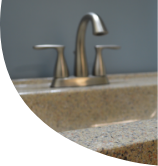4 Ways to Make Bath Time Safer
Bath time safety is important at any stage in life, from infancy to adolescence. And according to NationwideChidrens.org, “every year, more than 43,000 children receive emergency treatment for bathtub — and shower related injuries.” So it is no wonder more and more people are looking into options to help keep their tubs as safe as possible. And luckily for the accident-prone people in your life there are a few options in this regard; however, it is important to acknowledge that there is no perfect solution and each of the four solutions is not without its downfalls. But first, let’s discuss who is most at risk…
Who Is at Risk
- More than half of all bathtub and shower related injuries occur to children under 5 years old.
- 2 year olds have the largest number of injuries.
- Young children have little strength and when they fall, they tend to topple head first. This causes young children to hurt their heads and faces more often than older children.
Bathmats
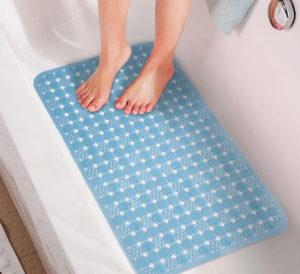
The least invasive option would be a rubber bathmat; usually equipped with suction cups to hold it stationary on the tub. This is intended to provide increased grip and stability while on the tub’s surface. And it can easily be removed from the tub to aid with cleaning. Although, the seasoned bather knows bathmats are famous for trapping dirt if left on the tub for an extended period of time. It is also important to note that suction cup bathmats are not approved for use on resurfaced tubs. The extreme stress from the mat being pulled from the tub can cause the coating to prematurely fail. For that reason bathmats that do not contain suction cups are the only ones approved for use on resurfaced surfaces. But since there is no way for the mat to adhere to the tub it is not the most ideal solution for a slippery surface. If using a suction cup bathmat is the something that you are not willing to live without then considering our tub casting service as opposed to our tub resurfacing service is certainly the better option.
Non Slip Appliqués/Stickers
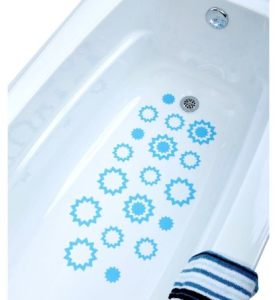
A temporary and fairly easy method to combat a dangerously slippery tub is the application of grippy sticker, that are also know as appliqués. They are essentially stickers, usually in whimsical shapes like flowers and butterflies. Or sometimes just thin strips that are designed to give the bottom of the tub grip and texture. These are the most common option for people who have the original tub in their home; in other words, not previously resurfaced. That is because they are not approved for use on resurfaced or casted tubs due to the damage they cause. The major downside to using appliqués is that is they are left on the tub for years, it can cause the rest of the tub to corrode around them. Meaning, the areas covered by the stickers could become noticeably raised in comparison to the exposed areas of the tub. This is an issue that is exacerbated by time and frequency of use. And all things to consider before committing to a resurfacing or casting service.
Non Slip Surfaces
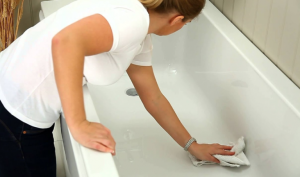
A more permanent option would be to have a non slip surface applied to the bottom of the tub. This is a gritty, textured surface that you can’t see but you can feel. It is designed to be a stealthy way to hide a safety feature in an otherwise glossy tub. And although it helps prevent slippage it should in no way be uncomfortable to sit on while taking a bath. A non slip surface can be applied to both resurfaced and casted tubs. The only downfall is that they trap dirt really easily, like reallllll easily. Even with regular cleanings it is common for the textured surface to stain or discolor. And because of its design it is nearly impossible to scrub without damaging the non slip or dulling the tub around it. So the once invisible non-slip may start to show up after a few months. Making this the solution for the person who values safety over a stained or slightly discolored tub.
Cut Outs/Safe Step
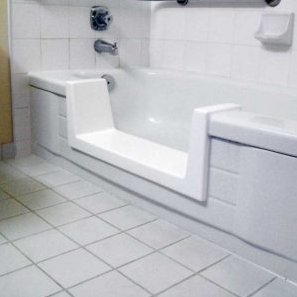 The most extreme measure or improvement one could make to their tubs is to add a cut out to the outside wall of their tub. This technically falls under the umbrella of “bath time safety” and this was designed with the elderly and/or handicapped in mind. The cut out allows the bather to enter the tub without fear of tripping or catching the edge of the tub with their foot. More of a fix for the bathers’ entrance and exit, as opposed to a fix related to general safety and preventing slippage than anything. The downside to opting for a cut out is time and money. And you’re cutting a chunk out of your tub, there is no coming back from that. And it should go without saying, but leave this to the professionals, please do not take a saw to your tub this weekend.
The most extreme measure or improvement one could make to their tubs is to add a cut out to the outside wall of their tub. This technically falls under the umbrella of “bath time safety” and this was designed with the elderly and/or handicapped in mind. The cut out allows the bather to enter the tub without fear of tripping or catching the edge of the tub with their foot. More of a fix for the bathers’ entrance and exit, as opposed to a fix related to general safety and preventing slippage than anything. The downside to opting for a cut out is time and money. And you’re cutting a chunk out of your tub, there is no coming back from that. And it should go without saying, but leave this to the professionals, please do not take a saw to your tub this weekend.
With a plethora of options out there to help make bath time as safe as possible you just need to ask yourself, “what are you willing to sacrifice for safety?”


